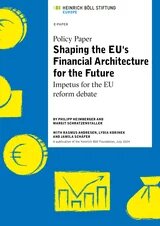The EU has already taken important actions for private finance to support the transition to a greener economy, and it cannot waste this one chance to finish the work. The sustainable finance legislative framework could help boost the European economy going forward – it is the last stretch before reaping the benefits of the efforts made so far.

In 2018, as part of the European Green Deal, the European Commission presented an EU action plan on sustainable finance. The aim of the plan was to support the green transition by redirecting capital towards sustainable investment, while at the same time managing the financial consequences of climate change.
According to some analysts, the results of the latest EU elections could weaken, and perhaps even jeopardise, the Green Deal, which would result in an inefficient sustainable finance legislative framework. The Green Deal is also facing corporate pressure due to the necessary effort to comply with the new rules. On the one hand, it asks larger companies to carry out due diligence on their value chains and report on their sustainability impacts, risk and opportunities, as well as establish transition plans for their business model in order to align with the objective of limiting global warming to 1.5°C. On the other hand, gradual development of the framework has led to legislative inconsistencies, leaving some businesses uncertain regarding how best to comply with the rules.
Despite this pressure, European citizens still consider the introduction of environmental legislation at the EU level as being crucial, while over 100 companies have issued a joint letter supporting the Green Deal in the wake of the elections.
The reality is that the EU has already taken important actions for private finance to support the transition to a greener economy, and it cannot waste this one chance to finish the work. The sustainable finance legislative framework could help boost the European economy going forward – it is the last stretch before reaping the benefits of the efforts made so far.
A complex framework
The EU sustainable finance regulatory framework is complex, and it is therefore important to understand how the different parts of this framework connect. Simply put, there are three pillars that form the backbone of the sustainable finance regulatory framework: the EU Taxonomy, the Corporate Sustainability Reporting Directive (CSRD) and the Sustainable Finance Disclosure Regulation (SFDR).
Together, these rules set the fundamental transparency requirements at investee, financial institution and financial product level, and act as reference points for other legislation designed to meet the goals of the EU Green Deal.
Criteria outlined in the EU Taxonomy, for instance, provide information that is used to create labels and schemes that boost sustainable investments, such as the EU Green Bond Standard. Likewise, both the EU Taxonomy and SFDR help increase transparency requirements for retail investors. The new rules make the sustainability characteristics of products clearer for investors and adaptations to the Markets in Financial Instruments Directive (MiFID II) enables them to express their sustainability-related preferences based on those characteristics.
Loopholes and inconsistencies
In principle, this network of rules can help the EU meet its sustainability targets. In practice, however, the loopholes in the framework have led to concerns and frustrations in the financial community, while the implementation of the framework has been plagued by inconsistencies.
Securing the quality, accuracy and transparency of sustainability-related information flows lies at the heart of the outstanding issues to address. A large part of the problem stems from the overly flexible approach when it comes to defining emerging sustainability concepts. These problems are leaving well-intentioned financial institutions with legal uncertainty, exposing them to evolving legislative interpretation and leaving sustainable investors without the clarity they need to truly invest sustainably.
These problems will clearly not be solved through pledges from the European Commission president to reduce reporting requirements by 25% or by deprioritising rules for sustainable finance at the EU level. Since sustainable finance operates within an interconnected framework that extends beyond the boundaries of each financial institution, a holistic and harmonised approach to replace the fragmented implementation of flexible rules must be pursued.
Sustainability concerns need to be fully integrated into companies’ governance structures, strategy, decision-making processes and accountability mechanisms. Entity boards and management should acquire the knowledge and skills to oversee sustainability risks and opportunities, and be held accountable for their decisions. Incentive structures should also be aligned by integrating transition plan elements into remuneration schemes.
In general, creating regulation that will accelerate the transition of both the financial system and the real economy is an iterative process that must continue into the next EU mandate.
Three fronts
In order to address the issues just mentioned, the current sustainable finance framework requires action on three major fronts.
EU policymakers must first finalise transparency and governance requirements. The former will ensure that information always remains accurate, fair and clear for end users, and that greenwashing and social washing do not distort risk assessments. The latter will bolster long-term decision-making in the financial world. Creating a robust definition of ‘transition finance’ and an improved definition of ‘sustainable investment’ are clear examples that will help avoid greenwashing.
Second, policymakers must also clarify the expectations related to the mandatory targets, both for managing sustainability risks and for developing a credible plan for a financial company’s activities to align with the target of limiting global warming as much as possible. Furthermore, legislators must improve enforcement measures to ensure rules are followed, and special attention must be given to how the rules are interpreted across different EU countries to avoid market fragmentation.
Third, it is also crucial to ensure that climate scenario analyses are based on climate science, realistic assumptions and technically sound economic models. The introduction of capital buffers for climate-related financial risks and the creation of robust transition plans to mitigate the financial stability impact of climate change will also be key for the EU and the financial sector going forward.
The road ahead
Given the different challenges and potential solutions mentioned, there are several key points to keep a close eye on as the new Commission takes office. Further developing support for sustainable investments by fostering the creation of financial investments dedicated to sustainable and net-zero projects is key. EU policymakers should make it a priority to improve their climate scenarios and enhance prudential capital requirements for banks and insurers to account for the climate-related financial risks of fossil fuel–based financing and investments.
Regarding specific legislation, an inadequate revision of the SFDR could see companies put forward transition efforts focusing on activities that are the most easy to transition, rather than those that have the highest impact. To avoid opening the door to further greenwashing, an unambiguous definition of the concept of transition finance needs to be introduced in the SFDR. When it comes to the Corporate Sustainability Due Diligence Directive (CSDDD), it only includes a limited number of corporate governance provisions. Steps must therefore be taken (specifically for financial institutions) to prevent the prioritisation of short-term performance at the expense of longer-term interests.
Above all, and despite growing corporate and political pressure, upcoming EU legislators must resist the push-back. Europe has already taken important steps to help private finance support the transition, and the bloc cannot waste this one chance to finish the job. Properly done, this framework could help turbocharge the European economy while preparing it for tomorrow’s sustainable markets.
The views and opinions in this article do not necessarily reflect those of the Heinrich-Böll-Stiftung European Union.


